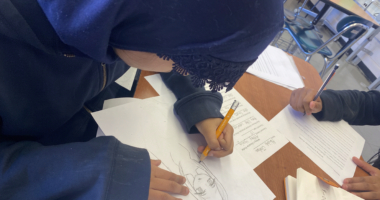As I approach the end of my internship, I feel thankful not just for the training I received to help me teach my art to students of varied backgrounds and ages, but also for how my own art practice has benefited from the experience.
Once, I read on a Snapple bottle cap a quote attributed to Picasso: that “every child is born an artist, the struggle is to remain one”. I have always been drawn to the child-like elements in art by artists like Kandinsky and Joan Miro. The simplicity of color, shape and play in their paintings—like a giant doodle drawn by a five year old—are very important. I went into the internship thinking that I could not only learn to be a Teaching Artist, but that the experience would benefit my writing practice, and it did.
As my training started last year, I was teaching introduction to creative writing to undergraduate students at NYU. Immediately I was trying to incorporate into that role what I learned at Community-Word Project. I was glad to see how important ritual and community were to the creative process. I began checking-in with my students at the beginning of class, created more exercises for reflection, and incorporated different teaching styles to address multiple intelligences.
I am fortunate to have completed this training while I was working towards an MFA in Poetry. At my residencies, I could see that the minds of second graders have not yet been molded into a role. Peer pressures and the directions from adults have not yet narrowed their perspectives. Their creativity can take any form. Though so young, their creative intelligence is as advanced as that of an adult. As I went to write poems towards my degree, I felt that some of my poems got a notch simpler, more playful. I allowed my work to seem more accessible, yet wackier too. How would a second grader see the world? How are we as grown ups no more intelligent, knowledgeable or confident? Perhaps, we merely have learned to be fiercer. My teacher at NYU, Charles Simic, advised us to write in a language that five-year-olds could understand.
For the second half of my residency I interned at an afterschool fairy tale theater class, comprised of mostly kindergarteners. The Teaching Artist, Kate Lee, has a background in experimental theater, incorporating the elements of process drama, including teacher in-role and play. On the first day of class, I found myself immersed in the minds of a group of five-year olds imagining themselves traversing through a forest, finding a giant speaking toad, or crossing a fire lake. As a poet, I believe the imagination to be no less real than the physical world. When I found myself working though imaginary scenarios with these young students, seeing the expression on their faces, how they would react to new scenarios and imagine a new scene to act out, I felt I was tapping into a great creative source. Directly and indirectly, I know these interactions permeated into my own poetry.
Early in May, I attended one of the Elective Seminars on teaching creative writing. The instructor, Kai Fierle-Hedrick, first had us go round the room and speak about our first memory related to language, noting how language is like a puzzle. Next, she set up four “Play Stations.” One station had magazines, posters, scissors, glue and white sheets of paper so we could create our own cut-out poems. Another station had an exercise to write a 4-line story, and the last station had materials to create concrete poems, poems that incorporate the visual elements of the words and letters into the poem (as a poem about a swan that is typed to look like a swan on the page). We were given some time to walk around the stations at will and play. This experience was very different from the more structured process of most of my master’s program. We in academia can sometimes feel shy or silly playing with scissors and glue. However, the bodily experience of walking around the room and playing like a five-year-old was great. We closed the session by sharing our work with a partner and discussing it. I told her how with the poetry magnets often found on refrigerators poems usually come out as lists, so I attempted to create some sort of loose narrative in my cut out poem. I am considering incorporating it into my manuscript:
There is California in snow
and you suddenly meet the sky
but traffic is like a headline
never perfectly in love
and I have been Hollywood rain.
-Paco Maquez, Poet, 2014-15 TATIP Trainee
Interested in TATIP? Find out more about our 2015-16 Program!
See more of our 2014-15 Graduates in the 2015 TATIP Anthology!



